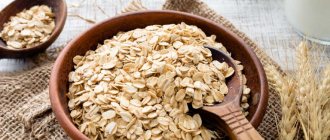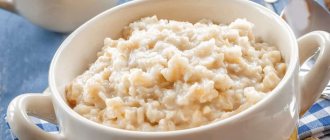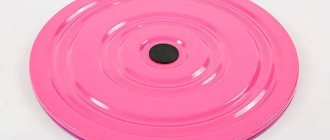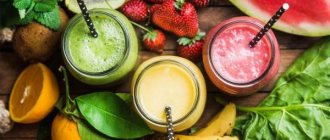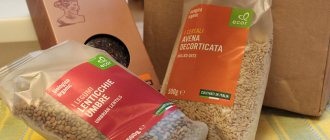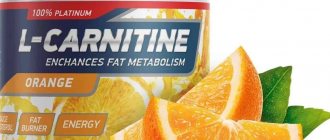Proper nutrition and a healthy lifestyle involve eating plenty of fresh fruits. These are natural sources of vitamins that strengthen the immune system and prevent many diseases. Unlike vegetables, their juicy, tender pulp satisfies even the most sophisticated tastes. The only question is how they affect the figure later. After all, they are sweet for a reason; they contain vegetable fructose. This is especially important for those who are losing weight or tend to be overweight. They need to choose only low-calorie fruits, but which ones are low-calorie fruits?
general information
What fruits are low-calorie?
In dietetics, low-calorie foods are those that have no more than 100 kcal per 100 g of weight. From this position, 90% of all fruits can be classified in this category. Those whose indicators exceed the specified value can be counted on one hand: avocado (170 kcal), green bananas (137), knistel (134), durian (147), ackee (151). So it’s difficult to make a wrong choice.
On the other hand, if we take the bulk of fruits, the calorie content of which does not exceed 100 kcal, several more groups can be distinguished among them:
- the lowest calorie (up to 30 kcal);
- just low-calorie (30-70 kcal);
- critically low-calorie (70-99 kcal).
Some may be interested to know that some nutritionists do not consider the latter group of fruits to be low in calories.
This article adheres to the generally accepted concept in dietetics and the system of proper nutrition that low-calorie fruits are fruits that contain no more than 100 kcal per 100 g.
Which ones to choose
By calorie content
In fact, all three categories are suitable for a diet according to the rules of PP and for weight loss. However, situations may arise when every ten calories matters when creating a menu. This happens especially often when following a diet, when this level is so minimal that it is difficult to choose the appropriate products. In this case, the lowest-calorie fruits will help out.
By sweetness
When losing weight, it is often not recommended to indulge in grapes, bananas and persimmons, as they are too sweet. Although, on the other hand, there are even diets based on these products, and when consumed correctly they do not contribute to weight gain.
By glycemic index
If you have diabetes and excess weight, you should pay attention not only to calorie content, but also to the glycemic index. Appetite and the speed of digestion of carbohydrates depend on this indicator. For example, watermelon is as low in calories as possible, but its GI is off the charts and amounts to 75 units. Melon, papaya, and pineapples are also at risk according to this criterion.
Many people know that low-calorie fruits in canned or any other form other than fresh cease to be so. When preserved, they are processed and sugar is added to them. So their benefits also decrease.
You can view the GI table for fruits.
How harmful is fructose?
Recently, fruits have been increasingly criticized for the fact that they contain a lot of fructose, which is both harmful to health and interferes with weight loss. In fact, nutritionists actively refute this point of view. They remind you that compared to the amount of vitamins, minerals, amino acids and antioxidants that a person gets from eating just one fruit, the amount of sugar consumed is practically irrelevant. All of it is spent on producing useful energy, and not storing fat. The body is perfectly adapted to absorb the doses of fructose that we get from fruits.
How much to eat per day
Daily intake of low-calorie fruits:
- for men with PP - 300-400 g;
- for men when losing weight - 200-300 g;
- for women with PP - 200-300 g;
- for women when losing weight - 100-200 g;
- for children - 200-300 g;
- for active sports – up to 450 g.
However, in all these cases, the determining factor is the calorie content. For example, you can eat more grapefruits and apples, since their calorie content is minimal. But with bananas and pomegranates you should be more careful and limit the serving size somewhat.
Need to quickly lose a couple of kilos? We suggest having a fasting day with fruit. Read recommendations and tips for carrying it out.
About tropical exotica
Along with those fruits that are familiar to us and form the basis of our daily diet, a large number of exotic ones have appeared in stores. There is an opinion that it is useful to include in food only those that grow in the area where you live. However, in this case, you will have to give up both bananas and citrus fruits, which simply do not ripen in cold zones.
Therefore, recently, even experts increasingly recommend expanding the diet of fruits as an inexhaustible source of vitamins. Moreover, lychees, mangosteen, carambola, and other tropical exotics have appeared in supermarkets. And for those who love to travel, it would be a shame not to try these wonders. Moreover, many of them are included in the list of the lowest calorie ones and even top them. The only warning is to study the information on how to eat them correctly, and start with minimal doses to avoid allergies and intestinal disorders.
What fruits should you not eat when losing weight?
Despite the effectiveness of the fruit diet, there are a number of fruits that are undesirable when losing weight.
These include fruits containing high amounts of carbohydrates and fructose:
- bananas are the highest calorie fruit;
- avocado - considered a heavy and high-calorie fruit;
- grapes – contains high fructose content;
- persimmon;
- papaya;
- figs;
- watermelon - frequent consumption disrupts the water-salt balance;
- dried fruits - high glucose content;
- cherry, sweet cherry;
- dates;
- peaches;
- blueberries, blackberries.
Of course, all these fruits are good for our body! But due to the high sugar content in them, as well as the increased calorie content, eating them is prohibited.
Since your main goal is weight loss, you will need to eliminate these foods for a while and replace them with others.
Lists
First of all, all those losing weight should take into account the list, which includes the lowest-calorie fruits (TOP-10):
- Momordica - creeper gourd (Africa, Australia).
- Syzygium - myrtle family (Malaysia, Australia).
- Cherry plum.
- Watermelons.
- Araz - myrtle family (Brazil).
- Capulin is a cherry-like fruit (Mexico, Guatemala).
- Lime.
- Carambola is a fruit in the shape of a five-pointed star (Sri Lanka, India, Indonesia).
- Lucuma is a sweet but low-calorie tropical fruit (Peru, Chile, Ecuador).
- Akebia is an Asian fruit that is stuffed with miso and chicken (China, Japan, Korea).
Since the leaders of this rating come from the tropics and cannot be found in a nearby store, the lowest-calorie fruit for our region is cherry plum (only 27 kcal). It is also the richest source of potassium, which is beneficial for the heart and blood vessels.
List of fruits with calorie content 34-40 kcal:
- bilimbi (cucumber tree) - oxalis family (Malaysia, Indonesia, Thailand, India);
- grapefruits;
- melons;
- cantaloupe - a type of melon (cultivated everywhere);
- lemons;
- tangerines;
- platonia - a huge fruit with aromatic and juicy pulp (Brazil, Paraguay, Colombia, Guyana);
- pomelo;
- santol - juicy, sweet, but at the same time low-calorie fruit (Vietnam, India, Cambodia, Indonesia, Southern Laos, Philippines, Malay Peninsula);
- Renet Semerenko apples are a winter variety, bright or light green, with a wine-sweet, spicy taste (widespread cultivation).
List of fruits with calorie content 41-49 kcal:
- apricots;
- oranges;
- pears of the varieties Bergamot, Bessemyanka, Duchess, Tyoma, Yuryevskaya;
- jaboticaba - tropical exotic with jelly-like juicy pulp (Brazil, Bolivia, Paraguay, Uruguay, Colombia, Philippines);
- Icaco - something between a plum and a grape (Africa, South America, Florida, Bahamas);
- kiwi;
- mineola;
- medlar is a sour fruit, but after long-term storage it becomes soft, sweet and tasty (widespread cultivation);
- nectarines;
- papaya - huge fruits with bright and tasty pulp (Mexico, USA);
- peaches;
- orange - citrus, a hybrid of tangerine and pomelo (widespread cultivation);
- sclerocaria - has juicy pulp, but a tart smell of turpentine (Africa);
- sour phyllanthus - pale yellow fruits with crispy juicy pulp (Madagascar, Vietnam, Laos, Indonesia, Malaysia, Hawaiian Islands);
- apples White filling, Granny Smith, Jonathan, McIntosh.
You can see the calorie content of each individual fruit in more detail at the end of the article in a special table.
passion fruit
If you're wondering what fruits to eat when losing weight, consider eating an exotic fruit like passion fruit.
Passion fruit, native to South America, grows on a beautiful flowering vine. This fruit has a tough yellow or purple outer skin with edible pulp and seeds inside.
One fruit (18 grams) contains only 17 calories and is a rich source of fiber, vitamin C, vitamin A, iron and potassium ().
For such a small fruit, passion fruit contains a fair amount of fiber. In fact, five fruits provide 42% of the RDA for fiber and contain less than 100 calories ().
Fiber slows down digestion, helps you feel fuller, and controls your appetite ().
Additionally, passion fruit seeds contain piceatannol, a substance linked to lower blood pressure and improved insulin sensitivity in overweight men. However, more research is needed ().
For weight loss, passion fruit is best consumed whole. It can be eaten alone, used as a topping for desserts, or added to drinks.
Summary:
Passion fruit is a low-calorie fruit with high levels of fiber, which may help normalize blood pressure and improve insulin sensitivity, potentially making it an ideal fruit for weight loss.
Most useful
If you are looking for the healthiest low-calorie fruits for your diet, then here are the leaders among them. Naturally, we selected those that are familiar and available in most stores.
- Apples
“Whoever eats an apple a day never sees a doctor.” Contain a lot of iron. Strengthen the immune system, improve digestion, reduce the risk of heart attacks, diabetes, Alzheimer's disease, and reduce cholesterol.
- Oranges
They contain a lot of folic acid, which is beneficial for women's health, especially during pregnancy. Cleanses the blood, tones, strengthens the immune system. Beneficial for men: increase potency, improve sperm quality. Accelerate metabolism and have a fat-burning effect.
- Grapefruits
Contain a large amount of ascorbic acid and antioxidants. They strengthen the immune system, lower cholesterol, reduce the risk of atherosclerosis and ischemia, have antimicrobial and antifungal properties, and increase the acidity of gastric juice. Grapefruits are known as fat burners and are especially useful for weight loss when combined with low-fat dairy products.
- Papaya
The fruits of this plant contain a lot of papain (an enzyme that facilitates the digestion of meat) and other plant proteins. They improve digestion, alleviate intervertebral osteochondrosis and bronchial asthma, are an anthelmintic, and prevent viral infections. Useful for women: reduce pain during menstruation, normalize the cycle.
- Kiwi
Contains a lot of potassium and folic acid. They strengthen the immune system, are recommended for hypertensive patients, replenish iodine deficiency, are useful for diseases of the thyroid gland and hormonal imbalance, reduce the risk of cancer, CVD, prevent the formation of blood clots, clearing blood vessels from plaques. Kiwis are fat burners, so they are often used in weight loss diets.
- Grenades
Contain a large amount of organic acids, iron and ascorbic acid. Product #1 for anemia. They lower blood pressure, strengthen the immune system, remove heavy metals and toxins from the body, and alleviate bronchial asthma.
- Pineapples
They contain organic acids (mostly citric acid), ascorbic acid, vitamins B1, B2, B3, B6, PP, A, potassium, iron. But the most valuable thing about them is bromelain, an enzyme that is credited with the ability to burn fat. It is for this reason that pineapples are so popular among those losing weight. They improve digestion, help cope with nausea during travel, remove excess fluid from the body, speed up metabolism, and relieve swelling and thrombosis.
- Pears
Few people know that they are included in the diet of some therapeutic diets - for example, for patients with diabetes and tuberculosis. Pears contain a lot of organic acids (mostly malic), pectin and tannins, phytoncides, vitamins A, B1, C. They normalize digestion, are completely absorbed by the body, eliminate fever, have analgesic, antiseptic and diuretic properties, and are used as a fixative for diarrhea. Helps stop severe coughing.
- Persimmon
Contains a large amount of beta-carotene and bioflavonoids. Useful for CVD, hypertension, anemia, early forms of toxic goiter. In Japan it is used in the treatment of atherosclerosis and scurvy, in Thailand - helminthiasis, in Korea - dysentery, bronchitis, enterocolitis. Normalizes lipid metabolism, which promotes weight loss. Has a diuretic effect.
Berries
Berries are also classified as fruits. They are low in calories and rich in nutrients.
For example, a 74-gram serving of blueberries contains only 42 calories but provides 12% of the RDA for vitamin C and manganese, and 18% of the RDA for vitamin K ().
One 152-gram serving of strawberries contains less than 50 calories and provides 3 grams of fiber, as well as 150% of the RDA for vitamin C and nearly 30% of the RDA for manganese ().
Eating berries also promotes a feeling of fullness in the stomach. One small study found that people given a 65-calorie berry snack ate less food at a subsequent meal than those given candy with the same number of calories ().
Additionally, eating berries may help lower cholesterol, lower blood pressure, and reduce inflammation, which may be especially beneficial for overweight people (,).
Both fresh and frozen berries can be added to cereal or yogurt for breakfast, added to smoothies and baked goods, or tossed into a salad.
Summary:
Berries contain few calories and many important vitamins. They may also have positive effects on cholesterol levels, blood pressure and inflammation.
Rhubarb
Rhubarb is actually a vegetable, but in Europe and North America it is often prepared as a fruit ().
Although one stalk contains only 11 calories, it also contains almost 1 gram of fiber and almost 20% of the RDA for vitamin K ().
Additionally, rhubarb's fiber may help lower high cholesterol, which is a common problem among people who struggle with excess weight.
In a study of 83 people with atherosclerosis - a disease of the arteries - those who were given 50 mg of dried rhubarb extract per kg of body weight for six months experienced a significant reduction in cholesterol levels and improved blood vessel function ().
Rhubarb stalks can be stewed and served with porridge or your favorite cereal. While it can be used in a variety of ways, including in desserts, it's best to stick to low-sugar rhubarb dishes when trying to lose weight.
Summary:
Rhubarb is low in calories and high in fiber, which may help reduce weight and cholesterol.
About calorie content and glycemic index
Knowing the calorie content and GI of foods, it is not difficult to create the right diet for weight loss. The glycemic index is a number that indicates the rate of increase in blood glucose levels after eating a product.
The coefficient depends entirely on the saccharides and fiber entering the body, the degree of processing of the product, and the ratio of carbohydrates to proteins and lipids. The normal GI value is 40-70. A figure over 70 is considered too high.
Calorie content is the amount of energy received by the body after taking products and breaking them down into simple components. The energy value of food is measured in kcal. Knowing the amount of carbohydrates, lipids, proteins, and fats in foods, it is easy to calculate the energy consumption received by the body after eating a particular dish.
Summarize
- Fruits are an essential part of a healthy diet and can help you lose weight.
- Most fruits are low in calories and high in nutrients and fiber, which can increase your stomach's feeling of fullness.
- Keep in mind that it is better to eat whole fruits rather than drink fruit juices.
- Moreover, simply eating fruit is not the key to losing excess body weight. You should also strive to eat a healthy, whole foods diet along with physical activity.
The article was prepared by experts for informational purposes only. It should not be used as a guide for treating medical conditions and is not a substitute for professional medical advice, diagnosis, or treatment. In case of illness or any symptoms, you should always consult a doctor and not self-medicate.
Tags: Weight loss
About the author: Maria Bartseva
General practitioner, expert in nutrition and weight management. Graduated from the International State Ecological University named after. A.D. Sakharova, Faculty of Environmental Medicine.
- Related Posts
- Top 23 Tips for Women on How to Lose Weight
- What is the ideal level of ketosis for weight loss?
- Leptin for Weight Loss: Do Leptin Pills Help You Lose Weight?
« Previous entry

